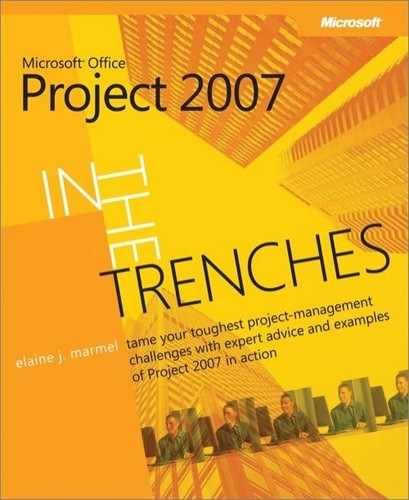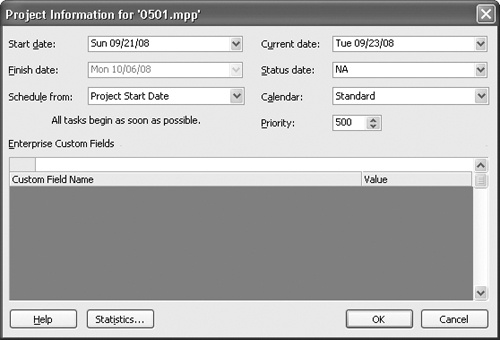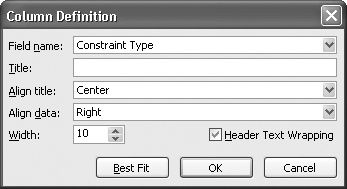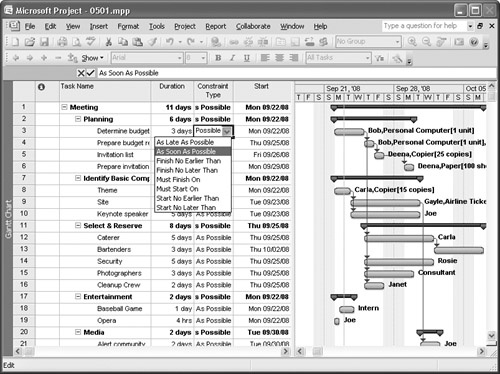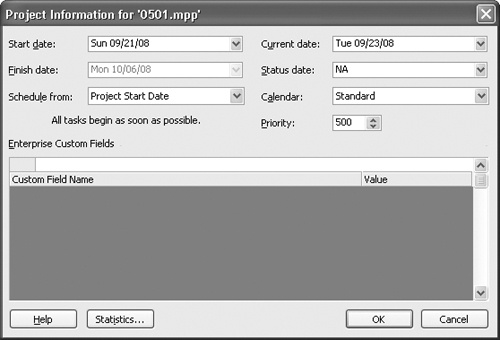In 1, I showed you how to use the Project Information dialog box to set the start date for your project. As you work on planning your project, Project uses the start date as the beginning point for all schedule calculations. Typically you don’t change the project start date during your planning; it simply isn’t practical, nor is there any real reason to change it until you’re ready to set a baseline and begin working on the project.
When you are ready to begin working on your project, on the Project menu, click Project Information to display the Project Information dialog box and set a beginning date for your project (see 5-22).
When you make a change to the project start date, Project automatically adjusts the tasks in your project to accommodate that start date, assuming that you didn’t use constraints or set start dates when you created the tasks in your project.
Most of the time, people set a start date for a project and all of the task timing flows from that date. After you set up all of the tasks in the project, project tells you when the project will finish, based on its start date.
In some cases, it makes more sense to drive a project from its ending date. For example, in the scenario I set up in the section "What Are Your Task Constraints Doing to Your Schedule?" it might make sense to schedule a project that closes the local office on a target date using that target date as the project’s finish date, because you need to know when to start the project to make sure that it finishes on time. In this case, you use the Project Information dialog box to establish a finish date for the project instead of a start date. When you schedule from the finish date, Project tells you when you have to start to complete the project by the specified finish date.
The Schedule From list in the Project Information dialog box controls whether you can set a start date or a finish date. By default, Project assumes you want to schedule from the project’s starting date, but if you want to schedule from an ending date, in the Schedule From list, click Project Finish Date. Project then makes available the Finish Date field and you can select a finish date; at the same time, Project disables the Start Date field.
If you schedule a project from its start date, Project automatically assigns the flexible As Soon As Possible (ASAP) constraint to each task you create. If you schedule a project from its finish date, Project automatically assigns the flexible As Late As Possible (ALAP) constraint to each task you create.
Be aware that although Project adjusts task dates automatically if you switch from scheduling using the project start date to scheduling using the project finish date, Project doesn’t change the ASAP constraint of tasks that already exist in your project—instead, those tasks continue to use the ASAP constraint instead of using an ALAP constraint. In addition, you’ll remove all leveling delays and splits that Project previously calculated.
In most cases, try to schedule your project from a start date, even if you know when the project should finish. You’re more likely to build a more realistic schedule if you schedule from a start date and let Project tell you how long the project will take to complete.
If you find out after you’ve begun working on setting up a project that you need to use backward scheduling, you can change the ASAP setting on tasks most easily if you display the Constraint Type column in any Gantt Chart view table. Place the cell pointer in the column that you want to appear to the right of the Constraint Type column, and then on the Insert menu, click Column. In the Column Definition dialog box (shown in 5-23), in the Field Name list, click Constraint Type.
When you click OK, Project adds a column to the table that identifies the constraint type assigned to each task (see 5-24). When you click any row in the Constraint Type column, you’ll see a list arrow; click the arrow to see the available constraint types and select As Late As Possible to change each task’s constraint type.
Project contains several different types of calendars: base, project, resource, and task calendars. Project uses these calendars when calculating your project schedule and resource availability. If you understand how these calendars interact with each other, you’ll also understand why Project calculates the schedule that you see. Using this information, you might be able to find ways to change the schedule.
The base calendar in Project serves as a model for all other calendars. Project comes with three base calendars: the Standard calendar, the 24 Hours calendar, and the Night Shift calendar. They each contain a fairly standard set of working times and non-working times, based on their names. You can use any of these base calendars directly in your project, you can create copies of these base calendars to use in your project, or you can create your own base calendars.
You use the project calendar to define your company’s working and non-working times. By default, Project assigns the Standard base calendar to your project; you can make changes to it to reflect holidays and other company-specific working time information. If you prefer, you can create your own base calendar and assign it to your project in the Project Information dialog box (see 5-25). If you don’t use any resource or task calendars, Project uses the project calendar to calculate your project’s schedule. See 1 for details on working with project calendars.
If you change a resource’s working time and then assign that resource to a task, Project schedules the task in the project using the resource calendar over the project calendar for tasks that do not have a fixed duration. So if September 1 through 14 are working days in your organization and Mary is on vacation during that time, Project won’t schedule Mary for any tasks during that time, although some work might occur on the task if you schedule other people to work on it. See 3 for details on working with resource calendars.
You use a task calendar to schedule a task using time that differs from the project calendar. For example, you might create a task calendar to schedule a task to be performed over a weekend when your project calendar designates weekends as non-working time. If you assign a task calendar to a task, Project schedules the task in the project using the task calendar over the project calendar. See the section "When Should You Use a Task Calendar?" earlier in this chapter for more information on task calendars.
So what happens when you use both a task calendar and a resource calendar? Project schedules the task to occur during hours common to both calendars. Suppose that you create a resource calendar for John that has him working Tuesday through Saturday. You then create a task calendar for Equipment Maintenance so that it will happen over a weekend. When you assign John to the Equipment Maintenance task, Project schedules the task to occur only on Saturday. You can then make the task calendar take precedence over the resource calendar. Double-click the task so that the Task Information dialog box appears and then click the Advanced tab. Next to the Calendar drop-down list, select the Scheduling Ignores Resource Calendars check box.
